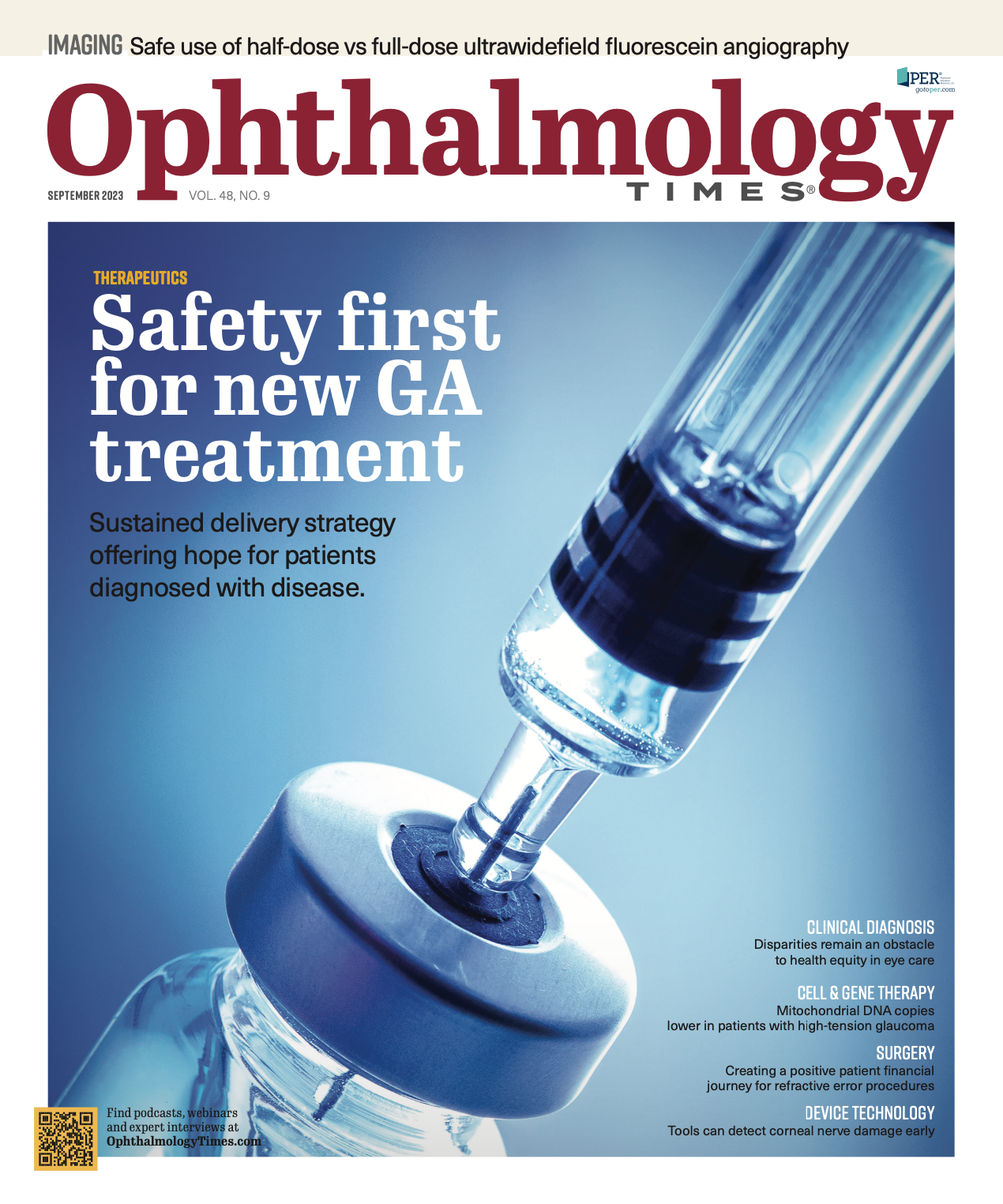Publication
Article
Digital Edition
Macular leakage is important in diabetic eye disease outcomes
Author(s):
Resolution of macular leakage is an early biomarker of vascular stability.
(Image Credit: AdobeStock/Jo Panuwat D)

Diabetic macular edema (DME) represents the greatest cause of vision impairment and blindness in diabetic populations around the world.1 Retina specialists often rely on optical coherence tomography (OCT), which looks at subretinal and intraretinal fluid accumulation in the macula, to guide their treatment of patients with DME.
OCT has largely replaced fluorescein angiography (FA) as the workhorse of the retina clinic, but there is still much that FA can offer when treating patients with DME. The Diabetic Retinopathy Clinical Research Network has recently highlighted the importance of ultrawidefield imaging as a prognosticator of outcomes based on peripheral retinal findings.2 Findings from several studies in patients with DME have established that change in macular leakage area correlates with functional and vision outcomes.
For example, a post hoc longitudinal analysis3 of the phase 2 RUBY study (NCT02712008) showed that reduction in macular leakage strongly correlates with vision improvements, including 1.05-letter reduction for every 1-mm2 increase in macular leakage area and 0.7-letter increase for every 1-mm2 decrease in macular leakage area. In data that I presented4 from the PANORAMA clinical trial (NCT02718326)5 in patients with moderately severe to severe nonproliferative diabetic retinopathy, increased macular leakage area at baseline in the sham-treated eyes was associated with increased risk of developing center-involving DME.
At the Association for Research in Vision and Ophthalmology Annual Meeting in New Orleans, Louisiana, this year, I presented a new post hoc analysis of the phase 3 YOSEMITE (NCT03622580) and RHINE (NCT03622593) studies on the reduction of macular leakage in patients with DME and its association with visual acuity and anatomical outcomes. My coinvestigators and I performed 2 sets of analyses: one looking at all patients in the trials regardless of treatment arm (faricimab or aflibercept) and one comparing faricimab and aflibercept during the head-to-head phase.
In the first set of analyses, we looked at the entire population of patients at week 16, when all eyes had received 4 monthly loading doses of faricimab or aflibercept. We divided these into quartiles of macular leakage and compared quartile 1, representing resolution of macular leakage (< 1 mm2), with quartile 4, representing persistent high levels of macular leakage (≥ 10 mm2). The patients with early resolution of macular leakage were more likely to experience greater best-corrected visual acuity, less fluid on OCT, and absence of intraretinal fluid at 1 year. Not surprisingly, the group with persistent high levels of macular leakage had more severe disease at baseline.
We examined whether there was a difference between faricimab and aflibercept on the change in macular leakage after 4 loading doses (a head-to-head comparison). The groups were balanced at baseline with about 25 mm2 of macular leakage; after 4 loading doses, the faricimab-treated eyes had about 50% less macular leakage than the aflibercept-treated eyes.
In addition, nearly twice as many patients treated with faricimab (28.4%) had resolution of leakage vs those treated with aflibercept (15.2%) at 16 weeks. Was this greater effect on macular leakage from faricimab driven by the molecule’s ANG-2 inhibition or simply by the higher molar dose of VEGF-A inhibition it provides? Here, data from the phase 3 PHOTON (NCT04429503; quadruple-dose aflibercept), and READ 3 (NCT01077401; quadruple-dose ranibizumab) trials provide the answer: Simply increasing the VEGF-A inhibition didn’t further improve the macular leakage vs the typical dose of aflibercept or ranibizumab.6,7
This body of evidence suggests that resolution of macular leakage is an early biomarker of vascular stability that correlates with a dryer retina and greater visual outcomes. The data also suggest a treatment that inhibits both VEGF-A and ANG-2 could reduce macular leakage to a greater degree than inhibiting anti-VEGF alone.
References
1. Daruich A, Matet A, Moulin A, et al. Mechanisms of macular edema: beyond the surface. Prog Retin Eye Res. 2018;63:20-68. doi:10.1016/j.preteyeres.2017.10.006
2. Marcus DM, Silva PS, Liu D, et al; DRCR Retina Network. Association of predominantly peripheral lesions on ultra-widefield imaging and the risk of diabetic retinopathy worsening over time. JAMA Ophthalmol. Published online August 18, 2022. doi:10.1001/jamaophthalmol.2022.3131
3. Sarici K, J. Ehlers, A. Martin. et al. Longitudinal Quantitative Ultrawide-field Fluorescein Angiography Dynamics in the RUBY Diabetic Macular Edema Study. Ophthal. Retina Published February 1, 2023. DOI: 10.1016/j.oret.2023.01.018.
4. Goldberg RA. Presented at: Retina Society 54th Annual Scientific Meeting; September 29 to October 2, 2021; Chicago, IL. Accessed July 2, 2023.
5. Study of the efficacy and safety of intravitreal (IVT) aflibercept for the improvement of moderately severe to severe nonproliferative diabetic retinopathy (NPDR) (PANORAMA). Clinical Trials.gov. https://clinicaltrials.gov/ct2/show/NCT02718326
6. Brown DM. Presented at: American Academy of Ophthalmology Annual Meeting; September 30 to October 3, 2022; Chicago, IL. Accessed July 6, 2023.
7. Do DV, Sepah YJ, Boyer D, Callanan D, Gallemore R, Bennett M, Marcus DM, Halperin L, Sadiq MA, Rajagopalan N, Campochiaro PA, Nguyen QD; READ-3 Study Group. Month-6 primary outcomes of the READ-3 study. Eye (Lond). 2015 Dec;29(12):1538-44. doi: 10.1038/eye.2015.142. Epub 2015 Jul 31. PMID: 26228291; PMCID: PMC5129796.

Newsletter
Don’t miss out—get Ophthalmology Times updates on the latest clinical advancements and expert interviews, straight to your inbox.




